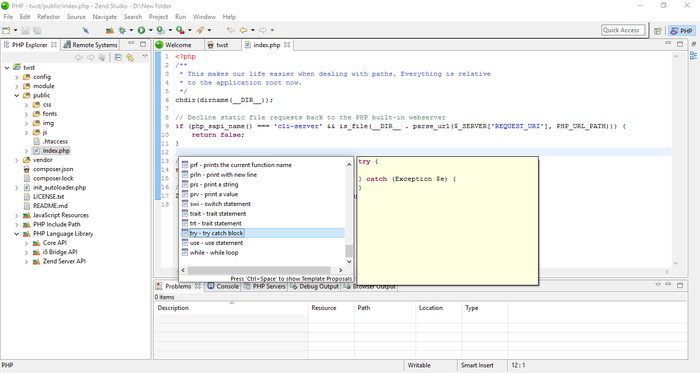

- #Zend studio 13.0.1 how to
- #Zend studio 13.0.1 install
- #Zend studio 13.0.1 upgrade
- #Zend studio 13.0.1 code
If you don’t deal with them termly, issues would be generated. So there is one thing you can be sure of: too many junks will slow down your computer, and they are accumulating during the operation. Removing the useless applications from your computer is still one of the simplest ways to speed up your system, where everything lives to work, occupying part of the hardware resources including hard drive space and memory.

#Zend studio 13.0.1 how to
Now go with how to correctly remove Zend Studio 13.0.1. If you happen to be a newbie of Mac Computer, take the chance to learn something. This page can help you understand the basic knowledge of system maintenance, guiding you through the confusion of removal problems. Removals on macOS are quite different from those on Microsoft Windows OS.
#Zend studio 13.0.1 upgrade
MariaDB 10.6.4 / utfmb3 encoding and collation / upgrade with a TNG 13.0.3 database import - Works fine.How to Remove Zend Studio 13.0.1 on macOS MariaDB 10.6.4 / utfmb4 encoding, utfmb3_general_ci collation / upgrade with a TNG 13.0.3 database import - Seems to be working OK (despite the fact that this was actually a mistake on my part) MariaDB 10.6.4 / utfmb3 encoding and collation / new installation - Stalled after table tng_repositories once MariaDB 10.6.4 / utfmb4 encoding and collation / new installation - Stalled after table tng_repositories once stalled after table tng_mediatypes once. (It's probably not a good idea, but you can select utfmb4 encoding and use utfmb3_general_ci collation.likely with strange results.)
#Zend studio 13.0.1 code
"collation" is a switch selected by TNG code when you create/import tables and refers to how fields are ordered when selected by queries. Finally."encoding" applies to the database itself and is chosen when the database is created. Both Oracle and MariaDB have stated that utfmb3 is supported but deprecated and that developers need to be moving to utfmb4. The ability to store utf8mb3 (3 byte Unicode) and utf8mb4 (4 byte Unicode) should be independent of the storage engine, unless Oracle (for MySQL) or the MariaDB Foundation actually built in something to prevent the usage of one encoding (or the other). Consequently, the way you write code to interact with an ISAM database is very different from the code you write to interact with an InnoDB database. (That last one has to do with an "all or nothing" view of how database operations are executed.) ISAM supports none of these features. The main difference between the two is that InnoDB supports transactions, rollback, and atomicity. InnoDB and MyISAM are storage engines and not the only ones supported by MySQL and MariaDB. My system: MariaDB 10.6.4 / PHP 7.4.2 / macOS 11.5.2 (otherwise known as "Big Suck". A second attempt stalled as well, but after getting not quite as far through the tables as the first. PHP does not appear to be working either. Process inspection shows that MariaDB does not appear to be doing any work (so.no live-lock though perhaps a deadlock, I suppose). Approximately half of the tables get created, and then.nothing. My first attempt to create a fresh TNG 13.0.4 test installation stalled at database table creation. One good positive development, though, was the possibility of leaving MySQL (and Oracle the owner of MySQL) behind forever with a move to MariaDB.Īll good.or so I thought.
#Zend studio 13.0.1 install
Now, with Apple making it harder and harder for software developers to install and manage development tools, I've had to switch to Brew for maintaining software that my TNG test installations require. I've successfully run MariaDB (the 'drop-in' successor to MySQL, created by the original team that authored MySQL many years ago) on my TNG live site for years.


 0 kommentar(er)
0 kommentar(er)
